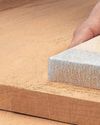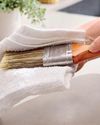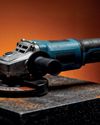SMART WOODWORKING
The Home Handyman
|Mar/Apr'25
In a world where technology touches nearly every aspect of our lives, it should come as no surprise that woodworking is also experiencing a digital revolution. From precision measuring tools and computer-controlled routers to smart dust extraction systems, the contemporary woodworking workshop is steadily transforming into a hub of innovation. These advancements are not only for large-scale factories or professional joineries –many tools and techniques are now accessible to the everyday enthusiast.
-

For hobbyists and small-scale entrepreneurs alike, the opportunity to integrate digital solutions into a home workshop brings multiple advantages. Smart woodworking allows you to reduce waste through highly accurate cuts, speed up repetitive tasks, and expand your creative horizons in ways that traditional methods may not always allow. Of course, cost is a factor, but many entry-level products are surprisingly affordable, and local hardware stores are increasingly stocking tech-friendly options that can be purchased for a few hundred to a few thousand rand.
This article explores how to bring technology into your woodworking space without losing the essence that makes working with wood so satisfying. We'll cover everything from digital measuring systems and mobile planning apps, to CNC routers, 3D printing, and dust collection solutions. The goal is to help you create a smart, efficient, and safe workshop that still honours the craft's long tradition of artistry and skill.
The evolution of the modern woodworking workshop
Woodworking has a rich history that dates back centuries. Craftspeople relied on hand tools such as chisels, saws, and planes to shape timber into everything from functional furniture to intricate sculptures. Over time, technological developments – like the invention of power tools – redefined how woodworkers approached projects. The table saw, the bandsaw, and the drill press each brought speed and precision that were not possible when working solely by hand.
Esta historia es de la edición Mar/Apr'25 de The Home Handyman.
Suscríbete a Magzter GOLD para acceder a miles de historias premium seleccionadas y a más de 9000 revistas y periódicos.
¿Ya eres suscriptor? Iniciar sesión
MÁS HISTORIAS DE The Home Handyman

The Home Handyman
KEEP YOUR HOUSE CRITTER FREE
With winter fast approaching, outdoor critters seeking to regulate their temperature are trying their best to get inside. Ants, spiders, moths, mosquitoes, fruit flies, stink bugs, termites, silverfish, and ladybugs, to name a few, can easily make their way into homes, and once they've settled in, it's often hard to get them out.
6 mins
Jul/Aug'25

The Home Handyman
SECRET HIDEOUTS
We all have things we would prefer to keep out of plain sight - family heirlooms, wedding rings, expensive jewellery, medicines or even weapons. Sometimes we just want to keep household items hidden in order to declutter a space. Whether you want to hide items for safety or financial reasons, or simply want to keep your bedroom tidy, there are a few clever storage ideas that could help you out.
2 mins
Jul/Aug'25

The Home Handyman
ABRASIVES DEMYSTIFIED
Abrasive materials are indispensable in countless industries, from woodworking and metal fabrication to automotive repair and electronics manufacturing.
3 mins
Jul/Aug'25

The Home Handyman
THINNERS VS. TURPENTINE
If you've ever finished a painting or staining job and been left wondering how best to clean your brushes, you're not alone. One of the most common DIY questions is: Should I use thinners or turpentine to clean my brushes? The answer depends on the type of paint or coating you've used. Using the wrong solvent can damage your brushes, or worse, make the cleaning job even harder.
2 mins
Jul/Aug'25

The Home Handyman
KEEP THE COLD OUT
Did you know that homes in South Africa are either insulated to a poor standard, compared to European nations, or have no form of insulation at all. In 2011 our National Building Regulations made it compulsory to fit thermal insulation in new buildings and additions to building structures.
5 mins
Jul/Aug'25

The Home Handyman
ANGLE GRINDERS — MASTERING THIS VERSATILE TOOL
When it comes to versatile tools in a DIYer's arsenal, few can match the power and practicality of the angle grinder.
2 mins
Jul/Aug'25

The Home Handyman
KITCHEN CARE – MAINTENANCE TIPS FOR KEY AREAS
The kitchen is the heart of the home where meals are made, memories are shared, and chaos sometimes reigns. But like any hardworking space, your kitchen needs regular maintenance to keep it functional, safe, and looking great.
2 mins
Jul/Aug'25

The Home Handyman
Separating Fact from Fiction
Maintaining your home can be a daunting task, especially with the plethora of DIY tips and tricks floating around the internet.
2 mins
Jul/Aug'25

The Home Handyman
SEALANTS SIMPLIFIED: WHAT TO USE AND WHERE
Whether you’re tackling a weekend DIY fix, remodelling your home, or involved in large-scale construction, sealants are a silent hero that play a vital role in creating watertight, airtight, and secure finishes.
3 mins
Jul/Aug'25

The Home Handyman
COMMON FRIDGE/FREEZER FAULTS
Your fridge freezer is one of the hardest-working appliances in your home, so when it stops performing as it should, it can cause major inconvenience. The good news? Not every fault means an expensive call-out or a trip to the shops for a new one. In many cases, you can fix the issue yourself with a little know-how and a few basic tools.
3 mins
Jul/Aug'25
Listen
Translate
Change font size

